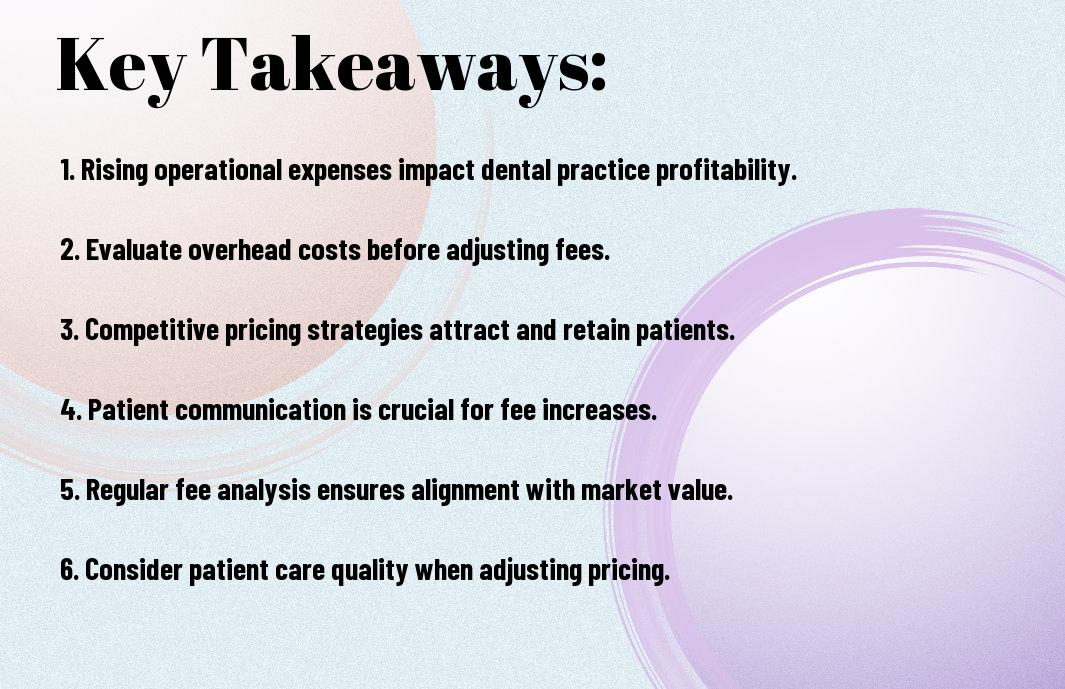Rising Costs in Dentistry – Is It Time to Raise Your Fees?
Most dental professionals, including myself, are feeling the pressure of rising costs in our field, which can affect the quality of care we provide. As expenses such as equipment, materials, and labor continue to climb, it’s vital to consider whether it might be time for a fee adjustment in your practice. This decision is not just about covering costs; it’s also about ensuring sustainable practice growth and maintaining high standards for your patients. In this post, I’ll explore various factors to help you make an informed decision.
Key Takeaways:
- Evaluating operational costs, including supplies, equipment, and staffing, can provide insights into whether fee adjustments are necessary.
- Market research on competitors’ pricing can help dental practices remain competitive while considering fee increases.
- Communicating transparently with patients about the reasons for any fee adjustments can enhance trust and retention.
- Assessing value-added services or patient experience enhancements can justify new pricing in a positive manner.
- Budgeting for potential future cost increases can safeguard practice profitability without frequent fee changes.

The Current Economic Landscape in Dentistry
As I navigate the evolving world of dentistry, it’s important to recognize the shifting economic landscape impacting our practices. Today, we are witnessing significant challenges, from increasing operational costs to fluctuating patient demands. Understanding these factors is vital for effectively managing your dental practice and ensuring its sustainability in the long run.
Inflation’s Impact on Dental Practice Expenses
Inflation is reshaping the financial dynamics of dental practices. As the cost of living rises, I find my expenses, including utilities, rent, and salaries, are climbing as well. This persistent increase in operational costs can strain my budget and may compel me to consider adjusting my fees to remain financially viable.
Rising Supply Chain Costs
Landscape disruptions have led to a noticeable increase in supply chain costs for dental professionals. I’ve observed that important dental supplies, from consumables to equipment, have surged in price. These changes can dramatically impact my practice’s bottom line, making it important to explore options to mitigate these costs while ensuring I maintain quality care for my patients.
Costs in the supply chain can fluctuate drastically due to various factors, including global shortages and increased transportation expenses. I often face challenges in securing important materials at reasonable prices, which can threaten the quality and efficiency of my services. Addressing these rising costs is vital for sustaining my practice, as they directly affect profit margins and operational viability. To navigate this landscape successfully, I must seek strategic partnerships with suppliers and evaluate my purchasing strategies.
Understanding Your Practice Economics
Now, as a dentist, it’s vital to grasp the economic landscape of your practice. By understanding your practice economics, you can make informed decisions about your fees and overall financial health. This involves a careful analysis of your costs, revenue streams, and profit margins. I recommend regularly reviewing these factors to ensure that your practice remains viable in the face of rising operational expenses.
Calculating Overhead Costs
The first step in understanding your practice’s economics is calculating your overhead costs. This includes fixed and variable expenses such as rent, utilities, staff salaries, and supplies. By identifying these costs, you can determine how much you need to charge to cover expenses and maintain profitability.
Analyzing Profit Margins
Understanding your profit margins is pivotal for the sustainability of your practice. You need to evaluate the difference between your total revenue and your total expenses to uncover how much of your income translates into profit.
For instance, if your practice generates $500,000 in revenue but incurs $400,000 in expenses, your profit margin is 20%. It’s vital to highlight that even a small decrease in revenue or an increase in expenses can significantly impact your profit margin. Additionally, if you fail to adjust your fees in response to increased operating costs, you risk your practice’s financial health. Conducting regular assessments helps ensure that your margins remain strong, allowing for potential reinvestment into your practice and better strategies for growth.
Signs That It’s Time to Raise Fees
To determine if it’s time to adjust your fees, look for key indicators in your practice’s financial health. Consistently rising costs, declining profitability, and feedback from peers can signal that the time has come to reassess your fee structure. By being proactive, rather than reactive, you can ensure your practice remains sustainable while continuing to provide quality care to your patients.
When Profitability Declines
Fees should reflect the costs and efforts involved in running your practice. If I notice a persistent decline in profitability, it may indicate that my current fees are not aligned with my operating expenses, especially considering inflation and rising costs in materials or labor.
Competitive Market Analysis
Among the many factors to consider, analyzing the competitive market is crucial. Understanding how my fees compare with those of nearby practices can reveal if my current pricing is too low, leading to financial strain or missed opportunities.
Time to evaluate your competitive landscape. Conduct a thorough market analysis by surveying local dental practices and their fee structures. You might find that your fees are significantly lower than the market average, which may negatively affect your revenue. Keep in mind that pricing too low can undermine the perception of quality in the services you provide. By aligning your fees with the market, you can enhance profitability and maintain a strong practice. Don’t hesitate to re-evaluate and adjust as necessary to meet the changing demands of your business environment.
Strategies for Fee Increases
Not all fee increases need to be drastic; implementing a thoughtful strategy can help you transition smoothly. You may choose to evaluate your expenses and adjust fees incrementally, which allows your patients to acclimate to the changes over time. Alternatively, comprehensive adjustments can be made if your costs have seen significant inflation. Consider the approach that aligns best with your practice’s culture and your patients’ expectations.
Incremental vs. Comprehensive Approaches
Against the background of rising operational costs, deciding between incremental and comprehensive fee increases is vital. While *incremental approaches* allow for gradual transitions and help maintain patient loyalty, *comprehensive increases* may be necessary when immediate adjustments are required to ensure sustainability. Evaluate your current situation and use data to inform your decision, keeping both your practice’s health and patient needs in mind.
Communicating Changes to Patients
By providing transparency during fee adjustments, you foster *trust and understanding* with your patients. Openly share the reasons behind the increase, such as inflation or enhanced services, while emphasizing your commitment to quality care. *Offering advance notice* can also allow patients to adjust to the changes, ensuring that this process is smooth and well-received. It’s important to convey that your practice’s goal remains patient-centered, even during challenging financial times.
Increases in fees can lead to *concern among patients*, so it’s vital to approach this communication with care. Begin by highlighting the *improvements in care* and any new technology or services that justify the increase. I recommend sending out personalized letters or having direct conversations to explain the rationale. This not only helps to reassure your patients but also presents an opportunity to emphasize your commitment to *maintaining high standards of dental care*. While fee adjustments may not be easy, effective communication can turn a potential issue into a positive conversation that strengthens your patient relationships.
Value-Based Fee Structures
After evaluating the ever-increasing costs of running a dental practice, I believe it’s imperative to consider why you need to raise your fees. Implementing value-based fee structures allows me to align my services with the outcomes that patients desire, ensuring they see the worth in what I offer. This approach not only helps maintain profitability but also enhances patient satisfaction by demonstrating the value of quality dental care.
Differentiating Your Services
Structures that differentiate your services can effectively communicate the unique value I provide. By clearly outlining the benefits and outcomes of each service, I can help patients understand why certain treatments are worth the investment. This clarity not only builds trust but also supports my justification for fee increases, as patients are more likely to invest when they see distinct advantages.
Creating Premium Service Options
Service offerings that position my practice as a provider of premium dental care can significantly elevate patient perceptions. By introducing options that include advanced technology, personalized treatment plans, and enhanced comfort during procedures, I can address a specific market segment willing to pay more for quality and convenience.
And by emphasizing these premium service options, I create an environment where patients feel valued and understood. This approach not only fosters loyalty but can also lead to increased revenue streams. Additionally, implementing these offerings can showcase my commitment to quality, setting my practice apart from competitors. By clearly communicating the advantages and carefully curating these premium services, I can strengthen both patient relationships and my bottom line.

Maintaining Patient Relationships During Fee Changes
Unlike many service industries, dental practices rely heavily on personal connections with patients. When I consider raising fees, I understand the potential impact on these relationships. It’s important to reassure patients that their care remains a priority, and that any adjustments are necessary to continue providing high-quality service. Keeping this trust ensures you can navigate changes effectively without losing valuable patient connections.
Transparency in Communication
Patient communication is key when implementing any fee changes. I find that openly discussing the need for adjustments helps in fostering trust. By clearly articulating the reasons behind the increase, you set a foundation for understanding and show your commitment to their dental health.
Offering Financial Options
Any discussion about fee adjustments should include financial options for patients. By presenting various payment plans, discounts, or financing services, you demonstrate flexibility and empathy towards their financial situation. This approach not only makes dental care more accessible but also helps mitigate any negative feelings regarding fee increases.
With multiple financial options, I can create a more accommodating environment for my patients. Offering payment plans allows them to manage the costs of dental care without feeling overwhelmed. Moreover, highlighting any insurance benefits or sliding scale fees can make a significant difference in their ability to continue seeking necessary services. This not only promotes patient retention but also reinforces that you truly care about their well-being and access to care.
To wrap up
With this in mind, I urge you to carefully evaluate your current fee structure in light of rising costs in dentistry. If you find that your expenses are increasing, it may be time to consider adjusting your fees to ensure that your practice remains financially viable. By doing so, you not only protect your practice but also maintain the quality of care you provide to your patients. Open communication and transparency with your patients about these changes can foster understanding and trust, ultimately benefiting everyone involved.
FAQ
Q: What are the main factors contributing to rising costs in dentistry?
A: Several factors are contributing to rising costs in dentistry, including increased overhead expenses such as rent, staff salaries, and equipment maintenance. Additionally, the cost of dental supplies and materials has seen a notable increase. Technological advancements in dental treatments also require investment, further driving up costs.
Q: How do inflation rates affect dental practice costs?
A: Inflation affects the costs of goods and services, including dental supplies, utilities, and labor. As the cost of living rises, salaries may need to be adjusted, resulting in higher operational costs for dental practices, which can influence the pricing of dental services.
Q: Is it common for dental practices to raise fees in response to increasing costs?
A: Yes, it is common for dental practices to review their fee structures periodically and adjust them based on rising operational costs. Many practices find it necessary to increase fees to maintain profitability while continuing to provide quality care to patients.
Q: What strategies can dentists implement to minimize cost increases without raising fees?
A: Dentists can adopt various strategies to minimize cost increases, such as optimizing inventory management, negotiating better rates with suppliers, and investing in more efficient technology that reduces labor or material costs. Additionally, expanding services or offering preventive care can enhance patient retention and overall revenue without directly raising fees.
Q: How should dentists communicate fee increases to their patients?
A: When informing patients about fee increases, it’s important for dentists to be transparent and provide clear reasoning behind the decision. Dentists can explain the necessity of the increase due to rising costs while emphasizing their commitment to quality care. Providing advance notices and personalized communication can help ease patient concerns.
Q: Are there any legal or ethical considerations when raising dental fees?
A: Yes, dentists should consider legal and ethical implications of fee increases. It’s vital to comply with local laws and regulations regarding pricing and billing practices. Ethically, practices should ensure that fee adjustments do not disproportionately affect vulnerable populations and should keep the lines of communication open with patients regarding their financial options.
Q: What alternatives exist for patients concerned about rising dental fees?
A: Patients concerned about rising dental fees can explore various alternatives. These may include dental insurance plans that can offset costs, discount dental plans, or financing options that allow for manageable payment plans. Additionally, many dental practices offer preventive care services that can save money in the long run by avoiding more expensive treatments.






you are really a good webmaster. The website loading speed is incredible. It seems that you’re doing any unique trick. Moreover, The contents are masterwork. you have done a great job on this topic!